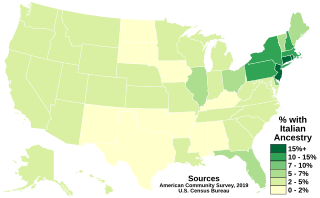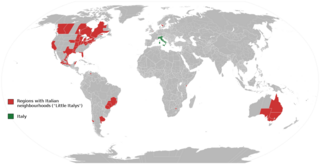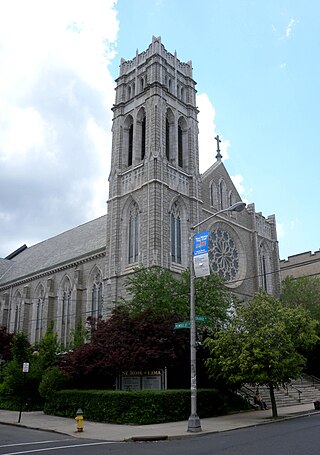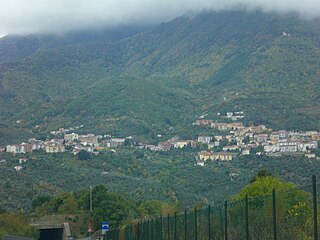
Italian Americans are Americans who have full or partial Italian ancestry. According to the Italian American Studies Association, the current population is about 18 million, an increase from 16 million in 2010, corresponding to about 5.4% of the total population of the United States. The largest concentrations of Italian Americans are in the urban Northeast and industrial Midwestern metropolitan areas, with significant communities also residing in many other major U.S. metropolitan areas.

Frances Xavier Cabrini, also known as Mother Cabrini, was an Italian-American Catholic religious sister. She founded the Missionary Sisters of the Sacred Heart of Jesus, a religious institute that was a major support to her fellow Italian immigrants to the United States.

Little Italy is the catch-all name for an ethnic enclave populated primarily by Italians or people of Italian ancestry, usually in an urban neighborhood. The concept of "Little Italy" holds many different aspects of the Italian culture. There are shops selling Italian goods as well as Italian restaurants lining the streets. A "Little Italy" strives essentially to have a version of the country of Italy placed in the middle of a large non-Italian city. This sort of enclave is often the result of periods of Italian immigration, during which people of the same culture settled or were ostracized and segregated together in certain areas. As cities modernized and grew, these areas became known for their ethnic associations, and ethnic neighborhoods like "Little Italy" blossomed, becoming the areas they are today.

San Margherita is an unincorporated neighborhood directly west of Columbus, Ohio, half falling into Norwich Township and the other half in Franklin Township. The area was settled in the early 20th century by Italian immigrants working for the Marble Cliff Quarry Company. Though once a robust and rural community, San Margherita is in danger of vanishing. Many of the original homes and locally owned businesses in the neighborhood have been demolished.

The Ironbound is a neighborhood in the city of Newark in Essex County, in the U.S. state of New Jersey. It is a large working-class multi-ethnic community, covering about 4 square miles (10 km2). Historically, the area was called "Dutch Neck," "Down Neck," or simply "the Neck," for its location by a bend of the Passaic River. Part of Newark's East Ward, the Ironbound is directly east of Newark Penn Station and Downtown Newark, and south and west of the river. The neighborhood is connected by the Jackson Street Bridge over the river to Harrison and Kearny.

Little Germany, known in German as Kleindeutschland and Deutschländle and called Dutchtown by contemporary non-Germans, was a German immigrant neighborhood on the Lower East Side and East Village neighborhoods of Manhattan in New York City. The demography of the neighborhood began to change in the late 19th century, as non-German immigrants settled in the area. A steady decline of Germans among the population was accelerated in 1904, when the General Slocum disaster decimated the social core of the population with the loss of more than 1,000 lives.

Broadway is a neighborhood within the city of Newark in Essex County, in the U.S. state of New Jersey. It is located on the west bank of the Passaic River, in Newark's North Ward, east of Forest Hill and north of Seventh Avenue. The neighborhood extends from Interstate 280 to Belleville. The term "Broadway" has only come into use recently, most Broadway residents simply refer to their area as part of the North Ward. The street itself "Broadway" was called "Washington Avenue" until the early twentieth century. Today, the area is predominantly Italian American, Puerto Rican and Dominican, with a growing population from other parts of Latin America. The New Jersey Historical Society was located here from the 1930s to 1997. The neo-classical Mutual Benefit building was constructed in the Broadway neighborhood in 1927. The district has many old brownstones in various states of repair. There are high-rise apartment buildings overlooking Branch Brook Park.

Roseville is a neighborhood in the city of Newark in Essex County, in the U.S. state of New Jersey. It borders Bloomfield and East Orange. To the neighborhood's immediate east is the Newark City Subway and Branch Brook Park. Roseville is divided into Upper Roseville north of 3rd Ave and Lower Roseville south of 3rd Ave.

Fairmount is a neighborhood in the city of Newark in Essex County, in the U.S. state of New Jersey. It is part of the West Ward. Its population is mostly African American. Central Avenue is the major street, though its commerce is considerably reduced from the Industrial Era heyday. The neighborhood is bounded by South Orange Avenue on the south, the Garden State Parkway on the west, Interstate 280 on the north, West Market Street on the north-east, and the University of Medicine and Dentistry of New Jersey on the east.

Little Italy, sometimes combined with University Village into one neighborhood, is on the Near West Side of Chicago, Illinois. The current boundaries of Little Italy are Ashland Avenue on the west and Interstate 90/94 on the east, the Eisenhower Expressway on the north and Roosevelt to the south. It lies between the east side of the University of Illinois at Chicago campus in the Illinois Medical District and the west side of the University of Illinois at Chicago campus. The community was once predominantly Italian immigrants but now is made up of diverse ethnic and socio-economic backgrounds as a result of immigration, urban renewal, gentrification and the growth of the resident student and faculty population of the University of Illinois at Chicago (UIC). Its Italian-American heritage is primarily evident in the Italian-American restaurants that once lined Taylor Street. The neighborhood is home to the National Italian American Sports Hall of Fame as well as the historic Roman Catholic churches Our Lady of Pompeii, Notre Dame de Chicago, and Holy Family.
"The Ride" is the 74th episode of the HBO original series The Sopranos and the ninth of the show's sixth season. Written by Terence Winter and directed by Alan Taylor, it originally aired on May 7, 2006.

Calabritto is an Italian town and a commune in the province of Avellino, Campania, Italy. It occupies a hilly-mountainous area at the eastern tip of the Monti Picentini range, in the upper Sele valley.

Italian Village is a neighborhood in Columbus, Ohio, that contains an array of residential, commercial, and industrial buildings. It is a designated historic district, known for its historical and cultural preservation. The building types and architecture reflect Italian influence. With its parks and preserved historic homes, Italian Village has the highest home value appreciation in Columbus.

Little Lima is a Peruvian enclave in Downtown Paterson, New Jersey, United States, and the largest Peruvian enclave outside of South America, home to approximately 10,000 Peruvian immigrants, by U.S. Census Bureau estimates. New Jersey's Peruvian population continues to grow in its urban areas, especially in Paterson, which is considered by many to be the capital of the Peruvian Diaspora in the United States. Meanwhile, East Newark, a smaller borough, in Hudson County, New Jersey, has the largest Peruvian percentage in the U.S. per capita, and New Jersey is home to the largest per capita Peruvian American population of any U.S. state.
Little Italy is a neighborhood in Downtown Paterson, New Jersey. The neighborhood is bound roughly by College Boulevard and Memorial Drive to the north, Cianci Street to the west, Ward Street to the south and Main Street to the east. Cianci Street is named for pastor of the St. Michael's Catholic church, Monsignor Carlo M. Cianci, who retired at the age of 85, in 1967. The neighborhood is closely situated near the growing Little Lima neighborhood to the south. It has a less defined presence and boundaries than it used to, but Cianci Street continues to have numerous Italian delis and restaurants. A Christopher Columbus statue is located in a small park near Cianci Street and McBride Avenue. Little Lima and Little Italy are both part of Paterson's first neighborhood, Dublin.

The Village is a neighborhood in the western section of Historic Downtown in Jersey City. It is bordered by Hamilton Park and Harsimus Cove to the east and the Turnpike Extension to the west, on the other side of which Jones Park and Mary Benson Park are located. Newark Avenue is the major street across the Village from Grove Street at the east to Bergen Hill at the west. The neighborhood for many years was considered the city's "Little Italy" neighborhood. Brunswick Street, between 1st and 10th Streets was once full of merchants and nicknamed "Bushel Avenue". St. Anthony of Padua Roman Catholic Church at 457 Monmouth St. received its historic designation on March 22, 2004. An annual feast organised by Holy Rosary Church on 6th and Brunswick Streets has taken place since the turn of 20th century.

St. Lucy's Church is a historic church at 19-27 Ruggiero Plaza at the intersection of Seventh Ave.in Newark, Essex County, New Jersey, United States. It is home to the American National Shrine of Saint Gerard Majella in the Catholic Church.

The Italians in Syracuse, New York number nearly 22,000 and are concentrated around the Little Italy of Syracuse, and the Northside of the city. Italian immigrants first settled in the area of Syracuse, New York beginning in 1883, after working on construction of the West Shore Railroad, that reached from New York City to Buffalo, New York. In Syracuse, they created an Italian-American community made up of immigrants from several regions of Italy and their descendants.

Little Spain was a neighborhood in the New York City borough of Manhattan, during the 20th century where Spaniards originally settled in upon emigrating to the United States. It was situated between the neighborhoods of Chelsea and Greenwich Village.

Vailsburg is a neighborhood in the city of Newark in Essex County, in the U.S. state of New Jersey. Part of the West Ward, its elevation is 280 feet (85 m). As of 2000, Vailsburg had a population of 34,348. The Vailsburg section of Newark is on a hill which closely aligns with the suburban and park areas outside it. Vailsburg includes the two smaller neighborhoods of upper Vailsburg and lower Vailsburg, both of which have Sanford Avenue as a focal point. Upper Vailsburg is closer to Maplewood and South Orange.



















